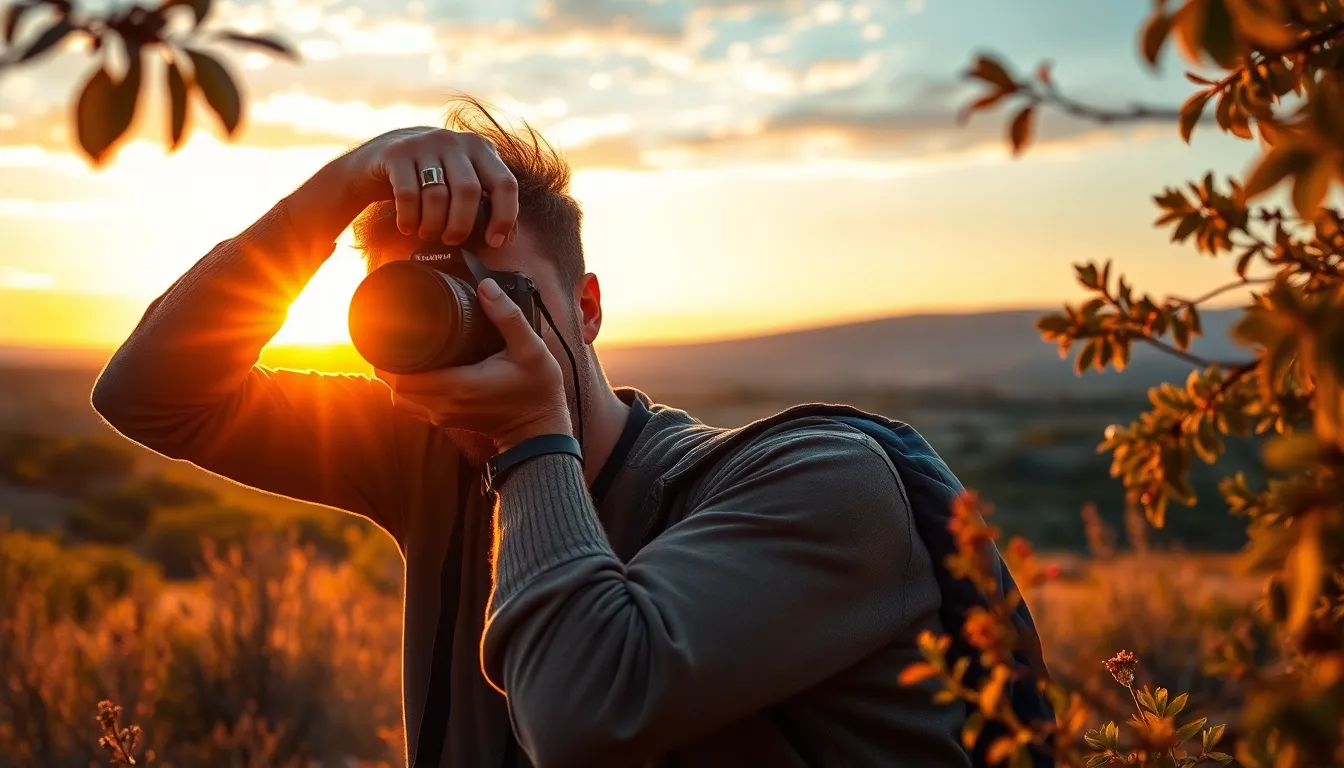Fine art photography isn’t just about snapping pretty pictures; it’s where creativity meets the lens in a dramatic tango. Imagine capturing the soul of a moment, transforming the mundane into the extraordinary. This art form invites viewers to ponder, feel, and sometimes even chuckle at the absurdity of life—all through a single frame.
Whether it’s a haunting landscape or a whimsical portrait, fine art photography pushes boundaries and challenges perceptions. It’s not just for gallery walls; it’s for anyone who believes that art can make the everyday a little more magical. So grab your camera, unleash your inner artist, and let’s dive into the captivating world of fine art photography—where every click tells a story and every image is a masterpiece waiting to be discovered.
Table of Contents
ToggleUnderstanding Fine Art Photography
Fine art photography transcends the act of taking aesthetically pleasing pictures. Through this medium, artists express emotions and convey deeper meanings, inviting viewers to engage with each unique narrative.
Definition and Characteristics
Fine art photography embodies artistic expression and the photographer’s vision. It focuses on creativity rather than commercial appeal. Key characteristics include a strong emphasis on composition, lighting, and subjects that provoke thought. Techniques vary, ranging from abstraction to realism, enabling diverse interpretations. Personal style often shines through, allowing artists to communicate their perspectives. Each photograph serves as a conceptual piece, evoking emotions and thoughts in viewers.
Historical Background
Fine art photography emerged in the mid-19th century, gaining recognition as an art form. Early pioneers like Julia Margaret Cameron and Alfred Stieglitz played vital roles in this development. The 20th century saw movements such as Surrealism and Modernism, which influenced contemporary practices. Technological advancements, including digital photography, expanded creative possibilities. Today, fine art photography embraces a variety of styles and techniques, reflecting cultural and individual narratives. This evolution underscores the medium’s ongoing significance in the art world.
Techniques in Fine Art Photography

Fine art photography employs various techniques that enhance artistic expression and visual impact. Understanding these techniques allows photographers to convey their unique vision effectively.
Composition and Framing
Effective composition plays a crucial role in fine art photography. The rule of thirds guides placement, encouraging balanced and dynamic images. Leading lines draw viewers’ eyes into the frame, creating depth. Negative space emphasizes the subject, adding intrigue and focus. Experimenting with symmetry and asymmetry can evoke different emotions. Unique angles and perspectives reveal fresh interpretations of familiar scenes, enriching the storytelling aspect.
Lighting Strategies
Lighting strategies significantly affect the mood and quality of fine art photography. Natural light creates soft, ethereal effects, while harsh light can produce dramatic contrasts. Golden hour, shortly after sunrise or before sunset, offers warm tones and soft shadows. Utilizing artificial lights provides versatility, allowing control over intensity and direction. Backlighting can create silhouettes, adding mystery and depth. Reflectors bounce light, softening shadows and highlighting details, enhancing the overall composition.
Notable Fine Art Photographers
Fine art photography showcases remarkable talents throughout history. Contemporary artists redefine visual storytelling, pushing boundaries and exploring new mediums and styles.
Contemporary Artists
Cindy Sherman stands out for her conceptual portraits, where she embodies various characters, challenging identity perceptions. Gregory Crewdson captivates viewers with his staged, cinematic scenes that evoke dreamlike narratives. Jeff Wall’s large-scale photographs blend tableau and cinematic aesthetics, often reflecting societal issues. Elspeth Diederix creates surreal images with hyper-realistic landscapes, emphasizing environmental themes. Each artist makes significant contributions, embodying diverse perspectives in contemporary fine art photography.
Classic Influences
Julia Margaret Cameron made her mark in the 19th century with her innovative portraiture and soft focus techniques, elevating photography as a serious art form. Alfred Stieglitz, a pivotal figure, advanced modernist photography while promoting its artistic recognition through galleries and exhibitions. Edward Weston excelled through his meticulous still life compositions, highlighting forms and textures. Ansel Adams developed the zone system, allowing photographers to control exposure and contrast effectively. These classic influences continue inspiring today’s fine art photographers, laying foundations for modern creativity.
The Emotional Impact of Fine Art Photography
Fine art photography evokes deep emotions, allowing viewers to connect with the imagery on a personal level. Different interpretations arise from each photograph, providing unique meanings that resonate with individual experiences.
Interpretation and Meaning
Artistic choices influence viewer perception significantly. Each photographer’s intention shapes the emotional narrative captured in their work. Abstract forms and striking contrasts can provoke thoughts on societal issues, while serene landscapes evoke peace and nostalgia. Context also plays a vital role; understanding a photographer’s background or the historical relevance of a scene enhances interpretations. Therefore, fine art photography serves as a bridge between personal emotion and broader cultural dialogues.
Viewer Engagement
Viewer engagement sustains the essence of fine art photography. Captivating images draw viewers in, sparking curiosity and encouraging exploration. Intriguing compositions invite viewers to return and experience the art anew, each encounter revealing different layers of meaning. Intentional use of color and light enhances this connection, guiding emotions and responses. Engaged viewers often share their interpretations, fostering conversation and enriching the collective appreciation of the art form. As a result, fine art photography cultivates an ongoing dialogue that deepens emotional investment.
Fine art photography serves as a powerful medium for artistic expression and emotional connection. It encourages viewers to explore the layers of meaning within each image and engage with the world in a more profound way. The unique stories captured through the lens not only reflect the photographer’s vision but also resonate with individual experiences.
As the art form continues to evolve, its ability to inspire and provoke thought remains unwavering. Whether through innovative techniques or timeless themes, fine art photography invites everyone to appreciate the beauty and complexity of life. Embracing this art form can truly transform the ordinary into the extraordinary, enriching the viewer’s perspective.
